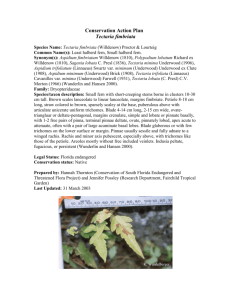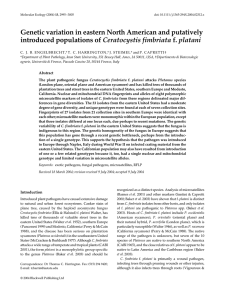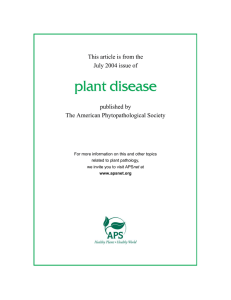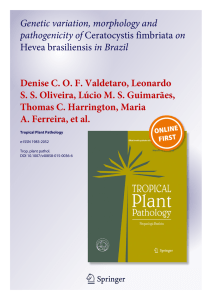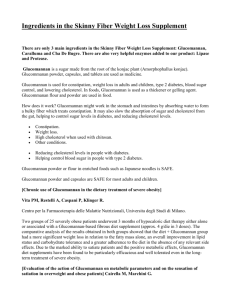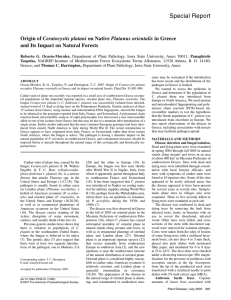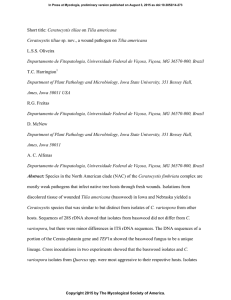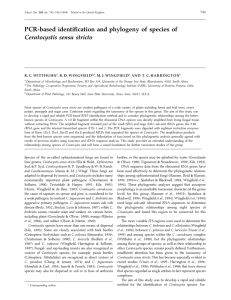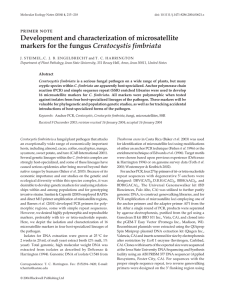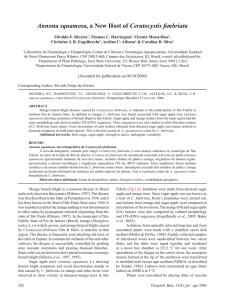Colocasia esculenta Ceratocystis fimbriata Thomas C. Harrington , Daniel J. Thorpe
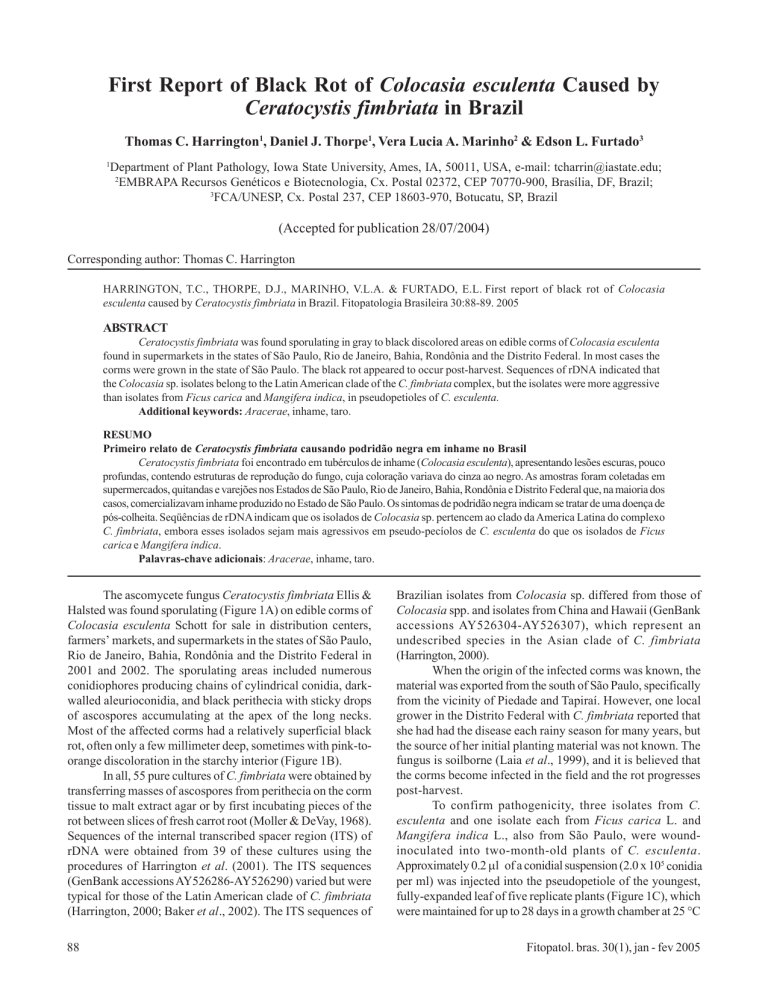
First Report of Black Rot of Colocasia esculenta Caused by
Ceratocystis fimbriata in Brazil
Thomas C. Harrington
1
, Daniel J. Thorpe
1
, Vera Lucia A. Marinho
2
& Edson L. Furtado
3
1 Department of Plant Pathology, Iowa State University, Ames, IA, 50011, USA, e-mail: tcharrin@iastate.edu;
2 EMBRAPA Recursos Genéticos e Biotecnologia, Cx. Postal 02372, CEP 70770-900, Brasília, DF, Brazil;
3 FCA/UNESP, Cx. Postal 237, CEP 18603-970, Botucatu, SP, Brazil
(Accepted for publication 28/07/2004)
Corresponding author: Thomas C. Harrington
HARRINGTON, T.C., THORPE, D.J., MARINHO, V.L.A. & FURTADO, E.L.
First report of black rot of Colocasia esculenta caused by Ceratocystis fimbriata in Brazil. Fitopatologia Brasileira 30:88-89. 2005
ABSTRACT
Ceratocystis fimbriata was found sporulating in gray to black discolored areas on edible corms of Colocasia esculenta found in supermarkets in the states of São Paulo, Rio de Janeiro, Bahia, Rondônia and the Distrito Federal. In most cases the corms were grown in the state of São Paulo. The black rot appeared to occur post-harvest. Sequences of rDNA indicated that the Colocasia sp. isolates belong to the Latin American clade of the C. fimbriata complex, but the isolates were more aggressive than isolates from Ficus carica and Mangifera indica , in pseudopetioles of C. esculenta.
Additional keywords: Aracerae , inhame, taro.
RESUMO
Primeiro relato de Ceratocystis fimbriata causando podridão negra em inhame no Brasil
Ceratocystis fimbriata foi encontrado em tubérculos de inhame ( Colocasia esculenta ), apresentando lesões escuras, pouco profundas, contendo estruturas de reprodução do fungo, cuja coloração variava do cinza ao negro. As amostras foram coletadas em supermercados, quitandas e varejões nos Estados de São Paulo, Rio de Janeiro, Bahia, Rondônia e Distrito Federal que, na maioria dos casos, comercializavam inhame produzido no Estado de São Paulo. Os sintomas de podridão negra indicam se tratar de uma doença de pós-colheita. Seqüências de rDNA indicam que os isolados de Colocasia sp. pertencem ao clado da America Latina do complexo
C. fimbriata , embora esses isolados sejam mais agressivos em pseudo-pecíolos de C. esculenta do que os isolados de Ficus carica e Mangifera indica .
Palavras-chave adicionais : Aracerae , inhame, taro.
The ascomycete fungus Ceratocystis fimbriata Ellis &
Halsted was found sporulating (Figure 1A) on edible corms of
Colocasia esculenta Schott for sale in distribution centers, farmers’ markets, and supermarkets in the states of São Paulo,
Rio de Janeiro, Bahia, Rondônia and the Distrito Federal in
2001 and 2002. The sporulating areas included numerous conidiophores producing chains of cylindrical conidia, darkwalled aleurioconidia, and black perithecia with sticky drops of ascospores accumulating at the apex of the long necks.
Most of the affected corms had a relatively superficial black rot, often only a few millimeter deep, sometimes with pink-toorange discoloration in the starchy interior (Figure 1B).
In all, 55 pure cultures of C. fimbriata were obtained by transferring masses of ascospores from perithecia on the corm tissue to malt extract agar or by first incubating pieces of the rot between slices of fresh carrot root (Moller & DeVay, 1968).
Sequences of the internal transcribed spacer region (ITS) of rDNA were obtained from 39 of these cultures using the procedures of Harrington et al . (2001). The ITS sequences
(GenBank accessions AY526286-AY526290) varied but were typical for those of the Latin American clade of C. fimbriata
(Harrington, 2000; Baker et al ., 2002). The ITS sequences of
88
Brazilian isolates from Colocasia sp. differed from those of
Colocasia spp. and isolates from China and Hawaii (GenBank accessions AY526304-AY526307), which represent an undescribed species in the Asian clade of C. fimbriata
(Harrington, 2000).
When the origin of the infected corms was known, the material was exported from the south of São Paulo, specifically from the vicinity of Piedade and Tapiraí. However, one local grower in the Distrito Federal with C. fimbriata reported that she had had the disease each rainy season for many years, but the source of her initial planting material was not known. The fungus is soilborne (Laia et al ., 1999), and it is believed that the corms become infected in the field and the rot progresses post-harvest.
To confirm pathogenicity, three isolates from C.
esculenta and one isolate each from Ficus carica L. and
Mangifera indica L., also from São Paulo, were woundinoculated into two-month-old plants of C. esculenta .
Approximately 0.2 µ l of a conidial suspension (2.0 x 10 5 conidia per ml) was injected into the pseudopetiole of the youngest, fully-expanded leaf of five replicate plants (Figure 1C), which were maintained for up to 28 days in a growth chamber at 25 °C
Fitopatol. bras. 30(1), jan - fev 2005
First report of black rot of inhame caused by ...
specialization seen in isolates from these and other hosts
(Harrington 2001; Baker et al ., 2003). It has been reported on
C.
esculenta (taro) in Asia and the Pacific, and there are also reports of the fungus on Xanthosoma spp. (also in the family
Araceae) in the Caribbean region (CABI, 2001). However, to our knowledge this is the first report of C. fimbriata on C.
esculenta in South America
FIG. 1 - A. Corms of Colocasia esculenta with gray, sporulating areas of Ceratocystis fimbriata . The corm on the right also has bacterial soft rot. B - A dry, black rot in the starchy tissue below sporulation by C. fimbriata . C - Dying leaf of an inoculated plant of C. esculenta .
The black arrow indicates the site of inoculation. D - Necrosis in the pseudopetiole at the site of inoculation (black arrow) and internal discoloration below the site of inoculation (white arrows).
and 16/8 h light/day. The linear extent of discoloration in the pseudopetioles averaged 7.8, 7.3, and 6.2 cm for the three
Colocasia sp. isolates (Figure 1D), and all 15 inoculated leaves died. The M. indica and F. carica isolates and the controls averaged 2.0, 1.4, and 0.5 cm discoloration, respectively, and only one of the leaves, inoculated with the Mangifera isolate, died. Duncan’s multiple range test indicated that the discoloration caused by the Colocasia sp. isolates was greater than that caused by the other isolates and the control ( P =
0.05). The fungus was successfully re-isolated from the inoculated pseudopetioles.
Ceratocystis fimbriata is well known on M. indica , F.
carica , Eucalyptus spp., Gmelina arborea Roxb., Theobroma cacao L. and other hosts in Brazil (Bastos & Evans, 1968;
Ribeiro & Coral, 1968; Muchovej et al ., 1978; Valarini & Tokeshi,
1980; CABI, 2001; Zauza et al ., 2004), but there is some host
LITERATURE CITED
BAKER, C.J., HARRINGTON, T.C., KRAUSS, U. & ALFENAS,
A.C. Genetic variability and host specialization in the Latin American clade of Ceratocystis fimbriata . Phytopathology 93:1274-1284.
2003.
BASTOS, C.N. & EVANS, H.C. Occurrence of Ceratocystis fimbriata Ell. & Halst. in Brazilian Amazonia. Acta Amazonica 8:543-
544. 1978.
CAB INTERNATIONAL. Ceratocystis fimbriata (original text prepared by C.J. Baker & T.C. Harrington). In: Crop Protection
Compendium. CAB International, Wallingford, UK. 2001.
HARRINGTON, T.C. Host specialization and speciation in the
American wilt pathogen Ceratocystis fimbriata . Fitopatologia
Brasileira 25:262-263. 2000.
HARRINGTON, T.C., MCNEW, D., STEIMEL, J., HOFSTRA,
D. & FARRELL, R. Phylogeny and taxonomy of the Ophiostoma piceae complex and the Dutch elm disease fungi. Mycologia 93:111-
136. 2001.
LAIA, M.L., ALFENAS, A.C. & HARRINGTON, T.C. Isolation, detection in soil, and inoculation of Ceratocystis fimbriata, causal agent of wilting, die-back and canker in Eucalyptus.
In: Proc. 12 th
Biennial Conference. Australasian Plant Pathology Society,
Canberra, Australia. Ed. By Morin. 1999. p.77.
MOLLER, W.J. & DEVAY, J.E. Carrot as a species-selective medium for Ceratocystis fimbriata . Phytopathology 58:123-124. 1968.
MUCHOVEJ, J.J., ALBUQUERQUE, F.C. & RIBEIRO, G.T.
Gmelina arborea – a new host of Ceratocystis fimbriata . Plant
Disease Reporter 62:717-719. 1978.
RIBEIRO, I.J.A. & CORAL, F.J. Estudo preliminary da ação do fungo Ceratocystis fimbriata Ell. and Halst., causador da seca da mangueira ( Mangifera indica L.), sobre cacaueiros ( Theobroma cacao L.). Bragantia 27:87-89. 1968.
VALARINI, P.J. & TOKESHI, H. Ceratocystis fimbriata : agente causal da seca de figueira e seu controle. Summa Phytopathologica
6:102-106. 1980.
ZAUZA, E.A.V., ALFENAS, A.C., HARRINGTON, T.C.,
MIZUBUTI, E.S. & SILVA, J.F. Resistance of Eucalyptus clones to
Ceratocystis fimbriata . Plant Disease 88:758-760. 2004.
03181
Fitopatol. bras. 30(1), jan - fev 2005 89
